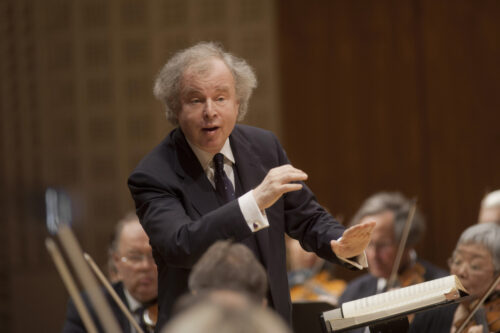 Switzerland Mozart, Schubert: Cappella Andrea Barca / Sir András Schiff (conductor and piano). Tonhalle, Zurich, 5.11.2021. (GA)
Switzerland Mozart, Schubert: Cappella Andrea Barca / Sir András Schiff (conductor and piano). Tonhalle, Zurich, 5.11.2021. (GA)

Mozart – Piano Concerto No.9 in E♭ major, K.271
Schubert – Symphony No.5 in B♭ major, D.485
Mozart – Piano Concerto No.27 in B♭ major, K.595
Schubert – Piano Sonata No.20 in A major, D.959: Andantino
Concertgoers filtering into Zurich’s Tonhalle auditorium found themselves confronted with the sight of Sir András Schiff’s massive Bösendorfer, its oxblood-red, flame-grained wooden case smouldering darkly through the highly polished lacquer finish. For Mozart? And when the musicians filed in, it became even clearer that this was to be no period-correct performance: all carried modern instruments, though the horns did have a certain patina. The flute was your conventional Böhm ‘rainpipe’. It was thus certain that no one would have difficulty hearing the performers – not that this was a serious concern, as the acoustics of the newly refurbished Tonhalle are excellent.
Cappella Andrea Barca is a more-or-less proprietary group founded and led by Sir András Schiff. It has accompanied Sir András through many projects, in many countries, and for over two decades. This programme, presented in multiple venues, requires relatively modest resources: few winds, no percussion and commensurately few strings: a streamlined, flexible and experienced ensemble, therefore.
So what went wrong?
During the initial piano concerto, Mozart’s No.9, the accompaniment refused to meld, to marry, with the soloist. The oboe scraped against the piano; and the whole lacked precision and verve, transforming this delicate, youthful work into something ill-defined, unfocused. The Andantino second movement gave Sir András occasion to rise free of his accompaniment: and this he did, notably in the last tentative, searching bars of the movement. The subsequent Rondo found Mozart’s irrepressible drive curiously … repressed. The word ‘under-rehearsed’ comes to mind – but with such players? Or was there a tuning issue? The Cappella had tuned before taking the stage. Did it have to battle against a divergence between its concert pitch and that of the piano? We shall likely never know.
The Schubert symphony that followed saw the veil lifted, in any event: the orchestra was thoroughly in tune with itself, and after the pause, in the evening’s second Mozart concerto, any piano/orchestra issues had clearly been addressed.
When Schubert, at the tender age of 19, composed what was already his Fifth Symphony, he was totally under the spell of Mozart: indeed, one writer irreverently refers to him in this period as a ‘Mozart fanboy’. As a result, this programme was, paradoxically, as unified as it was diverse: as much Mozart–’Mozart’–Mozart as it was Mozart–Schubert–Mozart.
On the podium, Sir András’s conducting was just as restrained as it had necessarily been from the keyboard; and though his precision and clarity cannot in any way be faulted, the result might have been better if he had ‘ridden’ his charges harder. The sound was fuller and more convincing, and the winds were on board, but it was difficult not to feel that a certain tension was missing. It wasn’t until the closing Allegro vivace movement that the manic tempo caught up the ensemble in a sprightly display of the full, rich sound of which they are clearly capable.
With Sir András once again at the piano, Mozart’s Piano Concerto No.27 proved to be the experience of the evening. The Allegro first movement seemed at times to be a dialogue between soloist and ensemble, the first following daydreams wherever they led, the second, more structured, sometimes warning, sometimes teasing or mocking, bringing things firmly back to earth. And the soloist teasing back as well: ‘Nya, nya, nya!’ Both ‘interlocutors’ entered fully into the spirit of the exchange, revealing teamwork of a calibre not seen before. Although … for his part, Sir András did not seem to be working at all: no, his ‘play’ appeared to be indeed play; his hands needing only to brush lightly over the keyboard to release the most astoundingly pearl-perfect runs and trills.
Perhaps as a matter of strategy, however, Sir András’s style of playing was not particularly clever in the Larghetto second movement. After all, a slow piece played with perfect sang-froid is visually unremarkable. But his nonchalance continued through the Allegro final movement where the pianistic going is much rougher. For after stating the buoyantly exuberant theme – a theme that Mozart was quick to ‘release as a single’ (i.e., publish as an eminently singable stand-alone song, ‘Komm, lieber Mai’) – the pianist enters into a series of complicated evolutions including a demanding coda. Yet amidst all that, Sir András was the picture of quiet conviction, of unhurried excellence. Only once did we see surface a vestigial fragment of ostentation: when he used a crochet rest to turn his palms upward, and – was that a shrug? – seemingly say, ‘See how easy? Nothing to it, folks!’
Most encores are full of sound and fury. For his single encore, Sir András chose something different: the relatively tranquil second movement from Schubert’s Piano Sonata No.20 in A major, D.959, written in the composer’s last months. The Andantino, initially measured and introspective, seems to portray outbreaks of defiance and frustration before returning to an attitude of stoic resignation. The choice of this piece went a long way towards explaining the choice of instrument, for it requires a full tone and a very solid bass, even in the low to very low end of the dynamic range. And by the way, Sir András’s playing was sublime.
Griff Anderson
